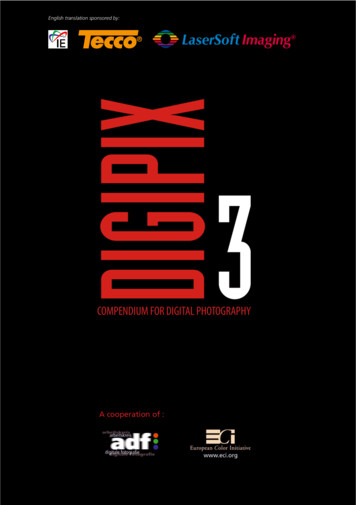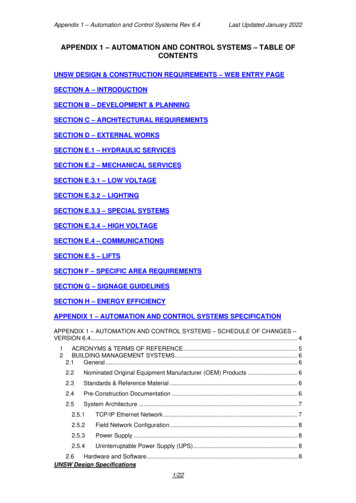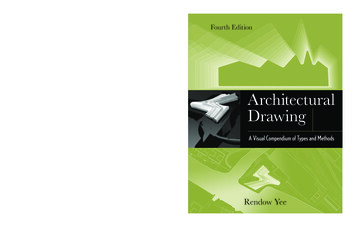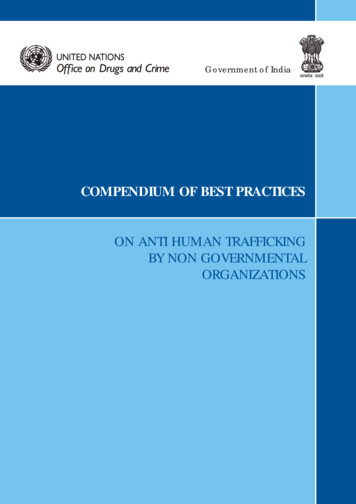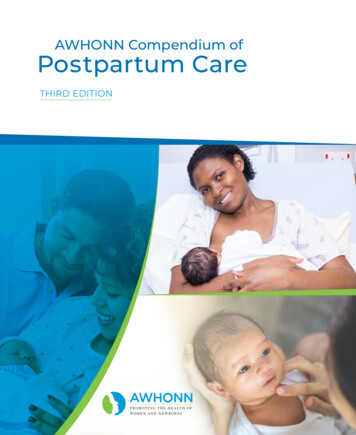
Transcription
Appendix F: Tool CompendiumName of tooland acronymEducational ReferencesPurpose and timing of toolHow Do I Use This Tool?Advantages and disadvantagesof tool5SMartin K. 5S: A powerfultool for creating highperforming healthcareorganizations. 2007Society for HealthSystems Conference;2007; New Orleans, LA;2007.A simple and powerfulperformance improvementtool that stands for the fivesteps to creating workplaceorganization: Sort,Straighten, Scrub,Standardize, and Sustain.Commonly misinterpreted assimply housekeeping, theimplementation of 5Sprovides benefits that are farmore than merely a neat andclean organization. Whenfully implemented, 5Seliminates the need tosearch for items, reduces theprobability of errors,increases productivity,improves quality, ensuresquicker response time,improves morale, andmodifies the appearance ofthe department to convey amore professional image.1. Sort: clear the area,reduce clutter and keeponly essential items2. Straighten: createdesignated locations,label everything3.Scrub: create a cleanand neat workplace4. Standardize:maintain the organizedworkplace5. Sustain: Ingrain 5Sinto workplace cultureExpertise: 1Pros: Simplifies work Creates safer workplace Reduces workforcefrustration Increases productivity Builds pride in workplace Builds customer confidence Reduces exposure to risk Reduces costs Easier to train new staff Makes problems visual Instills organizationaldisciplineResources: cleaningsuppliesCons: Can be time consumingWoodward H, SuskovichD, Workman-Germann J,et al. Adaptation of leanmethodologies forhealthcare applications.2007 Society for HealthSystems Conference;2007; New Orleans, LA;2007.Woodcock E. The leanthinking revolution.Mastering patient flow:using lean thinking toimprove your practiceoperations. 3rd ed.Englewood: MedicalGroup ManagementAssociation; 2009. p. 1140.Tague N. The tools. In:O'Mara P, editor. Thequality toolbox. 2nd ed.Milwaukee, WI: ASQQuality Press; 2005. p.93-521.A simple and powerfulperformance improvementtool that stands for the fivesteps to creating workplaceorganization: sort, set inorder, shine, standardizeand sustain. Focuses oncreating and maintaining anorganized and cleanenvironment.Commonly misinterpreted assimply housekeeping, theimplementation of 5SExample References
Name of tooland acronymEducational ReferencesPurpose and timing of toolprovides benefits that are farmore than merely a neat andclean organization. InEnglish, the five phases ofimplementation are Sort,Straighten, Scrub,Standardize, and Sustain.When fully implemented, 5Seliminates the need tosearch for items, reduces theprobability of errors,increases productivity,improves quality, ensuresquicker response time,improves morale, andmodifies the appearance ofthe department to convey amore professional image.Used: When an organization orpart of an organization isdisorganized and/oruncleanHow Do I Use This Tool?Advantages and disadvantagesof toolExample References
Name of tooland acronymEducational ReferencesPurpose and timing of toolHow Do I Use This Tool?5W2HTague N. The tools. In:O'Mara P, editor. Thequality toolbox. 2nd ed.Milwaukee, WI: ASQQuality Press; 2005. p.93-521.5W2H is a method for askingquestions about a process orproblem. Its structure forcesyou to consider all aspectsof the situation. The five Wsare who, what, when, where,and why. The two Hs arehow and how much (ormany).1. Review the situationunder study. Makesure everyoneunderstands the subjectof the 5W2H.2. Develop appropriatequestions about thesituation for each of thequestion words (who,what when, where, why,how, how much). Theorder of askingquestions is notimportant.3. Answer eachquestion. If answersare not known, create aplan for finding them.4. What you do nextdepends on yoursituation:If you are planning aproject, let yourquestions and answershelp form your planIf you are analyzing aprocess forimprovementopportunities, let yourquestion and answerslead you into additionalquestions aboutpossible changesIf you are defining aproblem, let yourquestions and answerslead you into causeanalysisIf you are reviewing acompleted project, letyour questions andanswers lead you intoadditional questions(Also called:5W2Hmethod,5W2Happroach)Mycoted. Creativity andinnovation techniques.2009. Available at:http://www.mycoted.com/Category:Creativity Techniques. Accessed August24, 2009.Used: When analyzing a processfor improvementopportunities When a problem has beensuspected or identified butmust be better defined When planning a project orsteps of a project (such asdata collection or rolling outchanges) When writing an article,report, or presentationAdvantages and disadvantagesof toolExample References
Name of tooland acronymEducational ReferencesPurpose and timing of toolHow Do I Use This Tool?about modifying,expanding, orstandardizing yourchangesIf you are preparing anarticle, report, orpresentation, includeanswers to thequestions in your textExpertise: 1Resources: noneAdvantages and disadvantagesof toolExample References
Name of tooland acronymEducational ReferencesPurpose and timing of toolHow Do I Use This Tool?Advantages and disadvantagesof toolAffinityDiagramsThe Hiser Group.Observe and analyse–Toolkit. 2006. Availableat:http://www.hiser.com.au/the hiser element toolkit/observe and analyse toolkit.html. AccessedMay 20, 2009.An affinity diagram helps tosynthesize large amounts ofdata by finding relationshipsbetween ideas. It organizesfacts, opinions and issuesinto natural groups to helpdiagnose a complexsituation and find themes.1. After brainstorming,write all ideas onseparate note cards orsticky notes. Spread allout on work surface.2. Group togetherrelated ideas.3. Discuss shape ofdiagram, patterns, etc.Label all groups.4. Combine groups into“supergroups” ifappropriate.Pros: Groups ideas in a mannerthat allows those with anatural relationship orrelevance to be placedtogether in the same group orcategory Promotes creativity Flexible in terms of user andsituation(Also called:affinity chart,K-J method)American Society forQuality. Idea creationtools: affinity diagram.2009. Available iontools/overview/affinity.html. Accessed June 22,2009.McCray M. How to getpaid for the services youprovide. 2007 Society forHealth SystemsConference; 2007; NewOrleans, LA; 2007.George M, Rowlands D,Price M, et al. Workingwith ideas. The lean sixsigma pocket toolbook.New York: McGraw–Hill;2005. p. 27-32.Tague N. The tools. In:O'Mara P, editor. Thequality toolbox. 2nd ed.Milwaukee, WI: ASQQuality Press; 2005. p.93-521.Bauer J, Duffy G,Westcott R, editors. Thequality improvementhandbook, ImprovementTools. 2nd ed.Affinity diagramming is ananalysis tool used to makesense of the unstructuredinformation captured duringfield studies, usabilityanalysis or evaluationactivities through a ‘bottomup’ group interpretativeprocess. Affinitydiagramming uses inductivethinking to organize largeamounts of qualitative datainto high-level conceptualgroups (‘affinities’) to revealunderlying issues andstructure. These in turnreveal usability implicationsfor an application’s design.Tool that gathers largeamounts of language data(ideas, opinions, issues) andorganizes them intogroupings based on theirnatural relationships. Usedwhen need to sift throughlarge volumes of data and/orto encourage new patternsof thinking.The affinity diagramorganizes a large number ofideas into their naturalrelationships. This methodtaps a team’s creativity andintuition.Affinity Diagrams are used to1. Gather ideas frombrainstorming session,or customer needstatements frominterview transcripts,surveys, etc.2. Write ideas on cardsor sticky notes.3. Post sticky notesrandomly on a board orflip chart, or on a table ifusing note cards.4. Allow people tosilently start groupingthe cards or notes.5. When the clusteringis done, create a“header” label for eachgroup.6. Do a second round ofclustering if desired.7. Complete thediagram and discuss theresults.1. Identify theproblem. Write theproblem or issue on ablackboard or flip chart.Note: If ideas or datahave already beengenerated, skip to step3.Cons: Can be time consuming Should have at least 15 itemsof information identifiedExample References
Name of tooland acronymEducational ReferencesPurpose and timing of toolHow Do I Use This Tool?Advantages and disadvantagesof toolAllocation ofFunctionAnalysisStanton N, Salmon P,Walker G, et al. Designmethods. Human factorsmethods: a practicalguide for engineering anddesign. Great Britain:Ashgate; 2005. p. 483504.Allocation of functionanalysis is used during thedesign process in order toallocate jobs, tasks,functions and responsibilityto the man or machine forthe system in question.Allocation of functioninvolves the design teamconsidering each task andthe relative advantages anddisadvantages associatedwith that task beingperformed by the man, or bythe machine. Allocation offunctions analysis isparticularly important whenconsidering systemautomation.1. Define the task(s)under analysis. Thefirst step in an allocationof function analysis is todefine the task(s) to beconsidered during theanalysis. It isrecommended that anexhaustive set of tasksfor the system underanalysis are considered.However, it may be thata number of the tasksare already allocated toeither the man ormachine and so onlythose tasks that requirefunctional allocationshould be considered.2. Conduct a HTA forthe task(s) underanalysis. Once thetasks under analysis aredefined, a hierarchaltask analysis (HTA)should be conducted foreach task or scenario.HTA involves breakingdown the task underanalysis into a hierarchyof goals, operations andplans. Tasks are brokendown into a hierarchicalset of tasks, sub-tasksand plans. It isrecommended that eachbottom level task step inthe HTA is consideredduring the allocation offunctions analysis.3. Conductstakeholder analysisfor allocation ofPros: Allocation of functionsanalysis is a simplisticprocedure that allows tasksto be allocated appropriatelywithin the system or deiceunder analysis Analysis of functions allowsthe designers to ensure thatthe tasks are carried out bythe most efficient systemcomponent Allocation of functionsanalysis provides a structureto the automation decisionprocess and also ensuresthat automation decisions aretraceable Provided that the appropriatepersonnel are used, theprocedure is a simple andstraightforward oneUsed: To allocate jobs, tasks,functions and responsibilityto the man or machine fora systemCons: The procedure can belaborious and timeconsuming, particularly forcomplex systems or devices A multi-disciplinarily team ofHF specialists, potential endusers, and designers arerequired in order to conductthe analysis properly. It maybe difficult to assemble sucha team.Example References
Name of tooland acronymEducational ReferencesPurpose and timing of toolHow Do I Use This Tool?functions. Astakeholder analysis isconducted in order toidentify stakeholdersatisfaction anddissatisfaction causedby changes in thecomputer systems in thesystem or type ofsystem under analysis.Observational study isrequired in order toconduct the stakeholderanalysis. Thestakeholder analysisinvolves determining thecurrent knowledge andskills of the existingstakeholders and thepotential of stakeholdersto develop newknowledge and skills.The analyst should alsoconsider a number ofaspects of work that areimportant to thestakeholders involved,such as thedevelopment of newskills, enjoyinginteraction with otherpeople and having avariety of work to do.4. Consider humanand computercapabilities. Next, theanalyst(s) shouldconsider each bottomlevel task step in theHTA and the associatedadvantages anddisadvantages ofallocating that task toAdvantages and disadvantagesof toolExample References
Name of tooland acronymEducational ReferencesPurpose and timing of toolHow Do I Use This Tool?the human operator orto the machine orsystem. The capabilityof the personnel and thetechnological artifactsinvolved should beconsidered with respectto each task step in theHTA. Each task stepshould be allocated tohuman only (H), thehuman and computerwith the human incontrol (H-C), thehuman and computerwith the computer incontrol (C-H), or thecomputer only (C).5. Assess impact ofallocation of functionon task performanceand job satisfaction.Once the tasks havebeen allocated, theanalyst(s) should revieweach allocation anddetermine the effectsupon task performanceand job satisfaction. Theanalysts shouldconsider error potential,performance timegains/losses, impactupon cost, mentalworkload and the jobsatisfaction criteriahighlighted earlier in theanalysis. For anyallocations that have asignificant negativeeffect upon taskperformance and jobsatisfaction, theAdvantages and disadvantagesof toolExample References
Name of tooland acronymEducational ReferencesPurpose and timing of toolHow Do I Use This Tool?analyst(s) shoulddetermine an alternativeallocation of function.The alternativeallocation of functionsfor the task step inquestion should then becompared, and the mostsuitable allocationselected.Expertise: 2Resources: noneAdvantages and disadvantagesof toolExample References
Name of tooland acronymEducational ReferencesPurpose and timing of toolHow Do I Use This Tool?AΔTAndersen B. Tools forimplementingimprovements. In:O'Mara P, editor.Business processimprovement toolbox.2nd ed. Milwaukee, WI:ASQ Quality Press; 2007.p. 237-49.The main purpose of AΔTanalysis is to set ambitioustargets for the improvementwork. The method is basedon the assumption that it isalways possible to find twodurations accumulatedcosts, total number ofdefects, or otherperformance measure for agiven process: “A” stands for actual: theactual time, costs, and soforth, currently related toperforming the process tobe improved “T” stands for theoretical:the theoretically fastesttime, lowest cost, and soforth, that can be achievedwhen performing theprocess The ratio is calculatedbetween the A and Tvalues: Δ A/T. This ratioexpresses theimprovement potential ineliminating all unnecessaryactivities and performingthe process as efficientlyas possible. The higher theratio, the higher thepotential. This ratio canalso be used as anexpression of how muchthere is to gain byapproaching the idealprocess.1. Start the analysisfrom the flowchart forthe current process.2. In the flowchart, addfigures for time, cost,number of defects, andso on, for each activity.3. Critically evaluateeach activity todetermine whether itadds value. If it doesnot, determine whetherit can be eliminated.Activities that can beeliminated are markedwith a color or by someother suitable means.4. Summarize the Avalues and the Tvalues, where the Tvalues are all the nonmarked activities, andcalculate the ratio A/T.5. Set theimprovement target ator close to the T value.Used: To set ambitious targets forthe improvement work With benchmarkingExpertise: 2Resources: flowchart,numerical data ofaccumulatedperformance measuresfor the processAdvantages and disadvantagesof toolExample References
Name of tooland acronymEducational ReferencesPurpose and timing of toolHow Do I Use This Tool?Advantages and disadvantagesof toolBalancedScorecardTague N. The tools. In:O'Mara P, editor. Thequality toolbox. 2nd ed.Milwaukee, WI: ASQQuality Press; 2005. p.93-521.The balanced scorecardsuggests that we view theorganization from fourperspectives, and to developmetrics, collect data andanalyze it relative to each ofthese perspectives:The Learning and GrowthPerspectiveThe Business ProcessPerspectiveThe Customer PerspectiveThe Financial Perspective.Within each perspective,measures chosen by theorganization reflect itsbusiness strategy. At everylevel of the organization,measures, targets, andactions are chosen thatsupport the overallorganization scorecard.Thus, the balancedscorecard allows everyoneto plan for and monitorimprovement on the issuesmost important to theorganization’s success.1. Reach a consensuson the vision andstrategy of theorganization.2. Consider what eachof these fourperspectives meansfor the organization:customer, internalbusiness, innovationand learning, financial.Decide whether thenames should bechanged to make theperspectives moremeaningful for theorganization, or even ifa perspective should beadded.3. For each perspective,choose no more thanfive measures thatwould indicate progresstoward achieving theorganization’s strategy.4. Choose ambitioustargets for eachmeasure that, whenachieved, will bring theorganization closer to itsvision of excellence.Pros: Prevents an organizationfrom creating improvementsin one area that hurt theorganization in another Helps a group think aboutwhich of several ways ofaccomplishing a goal wouldbe best for the organizationoverall A powerful tool for focusingstrategyTidd J, Bessant J, PavittK. SWOT analysis. 2001.Available e/pages/atoz/swot.htm.Accessed August 24,2009.The balanced scorecard is aset of measures that gives aquick overall view of theperformance of anorganization or businessunit. Measures are groupedinto four perspectives:customer, internal business,innovation and learning, andfinancial. Within eachperspective, measureschosen by the organizationreflect its business strategy.At every level of theorganization, measures,targets, and actions arechosen that support theoverall organizationExpertise: 1Resources: noneExample References
Name of tooland acronymEducational ReferencesPurpose and timing of toolHow Do I Use This Tool?Advantages and disadvantagesof toolExample ReferencesBenchmarkingCowan D.Benchmarking—Leadingmanagers to find andimplement betterpractices. 2007 Societyfor Health SystemsConference; 2007; NewOrleans, LA; 2007.Benchmarking is astructured process forcomparing yourorganization’s work practicesto the best similar practicesyou can identify in otherorganizations (related andunrelated; e.g. health careand manufacturing) and thenincorporating these bestideas into your ownprocesses.1. Identify what is tobe benchmarked. Bespecific in deciding whatthe team wants tobenchmark.2. Decide whichorganizations/functions to benchmark. Thecomparison should beconducted not onlyagainst peers but alsoagainst recognizedleading organizationswith similar functions(e.g. admissions to ahospital and hotel).3. Determine the datacollection method andcollect data. Keep thedata collection processsimple. There is no rightway to benchmark. It isimportant to lookoutward, be innovative,and search for new anddifferent ways toimprove the processunder study.4. Contact a peer inthe benchmarkorganization. Explainthe purpose of thebenchmarking study andwhat information isdesired. Give assurancethat confidentialinformation will not berequested. Inquire aboutthe peer’s organization:what they do, why theydo it, how they measureand/or evaluate it andwhat their performancePros: Exposes newapproaches/solutions toproblems Not difficult Can create huge leaps inperformance Establishes goals that areambitious yet realistic Helps the organizationunderstand and develop acritical attitude toward itsbusiness processes Encourages an open attitudetoward seeking and sharinginformation and thereby is anactive learning process thatmotivates change andimprovement in theorganization The organization can findnew sources of improvementand new ways of doing thingsoutside its own environment Reference points areestablished for performancemeasurement of businessprocessesCenters for Medicare &Medicaid Services.Physicians groupscontinue to improvequality and generatesavings under medicarephysician pay forperformancedemonstration. 2008.Available nloads/PGP Fact Sheet.pdf Accessed May 20,2009.American Society forQuality. Organizationwide approaches:Benchmarking. 2009.Available ng/overview/overview.html.Accessed June 23, 2009.Yanko S, Gomez E.Tools, techniques, andbest practices in theemergency room. 2007Society for HealthSystems Conference;2007; New Orleans, LA;2007.Woodcock E. The leanthinking revolution.Mastering patient flow:using lean thinking toimprove your practiceoperations. . 3rd ed.Englewood: MedicalGroup ManagementAssociation; 2009. p. 1140.Medical GroupManagementAssociation. MGMABenchmarking is acontinuous process andshould not be considered aone-time event. It is ongoingand should be incorporatedinto day-to-day work andintegrated into the way youthink about work, the wayyou solve problems and theway you learn.Benchmarking is the searchfor best practices, the onesthat will lead to superiorperformance. Establishingoperating targets based onthe best possible industrypractices is a criticalcomponent in the success ofevery organization.Benchmarking is a techniquefor learning from others’successes in an area wherethe team is trying to makeimprovements.The practice of beinghumbleenough to admit thatCons: Long-term commitment Requires a sufficient amountof process learning, projectplanning, and staff support Competitor information maynot be publicly available Benchmark may not be agood benchmark (containslots of waste, variability, etc.) Can require significantinvestments of manpowerand time Too broad a scope doomsBeam J, Rhodes S.Survivor—ED island.2007 Society for HealthSystems Conference;2007; New Orleans, LA;2007.
Name of tooland acronymEducational ReferencesPurpose and timing of toolHow Do I Use This Tool?Advantages and disadvantagesof toolpractice dashboards.2009. Available ssed July 10, 2009.someone elseis better at something andbeing wise enough to try tolearn how to surpass them atit.the project to failure Inadequate resources candoom a benchmarking studyUniversity Research Co.LLC. Quality AssuranceProject: Benchmarking.2008. Available w.html#benchmarking.Accessed July 28, 2009.Benchmarking is comparingyour practice’s performanceto the performance of otherpractices. It facilitates theunderstanding of physicianperformance and how yourpractice’s costs compare tosimilar practices. It relies onmeasurement, comparisonand metrics to facilitatemanagement. Becausebenchmarking measuresperformance at differenttimes, it’s an important toolfor observing changes in thepractice or physician activity.measures are, what hasworked well, and whathas not beensuccessful.5. Determine whetherwhat the team haslearned frombenchmarking can beapplied to improve theorganization’s process.Are there new anddifferent ways to solvethe problem or improvethe process? Are thereother solutions to theproblem that the teamhas overlooked? It’simportant to keep anopen mind about newand perhaps radicallydifferent ways of doingthings.George M, Rowlands D,Price M, et al. Selectingand testing solutions. Thelean six sigma pockettoolbook. New York:McGraw–Hill; 2005. p.253-76.Tague N. Mega-tools:Quality managementsystems. In: O'Mara P,editor. The qualitytoolbox. 2nd ed.Milwaukee, WI: ASQQuality Press; 2005. p.13-34.Bauer J, Duffy G,Westcott R, editors. Thequality improvementhandbook, ImprovementTools. 2nd ed.Milwaukee, WI: ASQQuality Press; 2006. p.109-48.Andersen B. Tools forcreating improvements.Benchmarking is: Continuous search for abetter way of doing things Continuous process toimprove productivity,operations, patient flow,quality, or cost Learning/discovery/improvement process Adaptive A planning process Collaborative Others’ cost are 10%lower, what do they dodifferentlyBenchmarking is asystematic approach forgathering information aboutprocess or productAccurately assess yourstrengths andweaknesses.Understand, andcompare yourself to, thebest practices in theindustry and/or itsleaders. Learn fromindustry leaders andyour competition.Reveal how and whythey are strong in agiven area. Do nothesitate to copy ormodify and incorporatethem in your ownoperation. Emulate theirstrengths.Identify other groups,Example References
Name of tooland acronymEducational ReferencesPurpose and timing of toolHow Do I Use This Tool?In: O'Mara P, editor.Business processimprovement toolbox.2nd ed. Milwaukee, WI:ASQ Quality Press; 2007.p. 167-236.performance and thenanalyzing why and howperformance differs betweenbusiness units. In otherwords, benchmarking is atechnique for learning fromothers’ successes in an areawhere the team is trying tomake improvements.organizations, or healthfacilities that serve asimilar purpose and thatappear to work well.They do not need to bedoing exactly what theteam does, as long as itcan be compared. Forexample, if the team isdealing with problems inhospital laundryservices, the team couldlearn from hotels anddormitories that providesimilar services,although they are not inthe same field and/or donot provide exactly thesame service. Visitthese sites and talk tomanagers and workers,asking them what theyare doing, if they havesimilar problems, whatthey have done about it,and what levels ofperformance they haveachieved. Ask as wellwhat obstacles theyhave run into and howthey have dealt withthem.Tidd J, Bessant J, PavittK. Innovationmanagement toolbox.2001. Available e/pages/atoz/atoz.htm.Accessed August 24,2009.Benchmarks are measures(of quality, time, cost, etc.)that have already beenachieved by some company,somewhere. They tell youwhat’s possible so you canset goals for your ownoperations. Benchmarkingcan be very helpful to injectnew ideas into the processand borrow the good ideasfrom othercompanies/industries.Benchmarking is astructured process forcomparing yourorganization’s work practicesto the best similar practicesyou can identify in otherorganizations and thenincorporating these bestideas into your ownprocesses.Benchmarking is anevaluation technique inwhich an organizationcompares its ownperformance for a specificprocess with the “bestpractice” performance of arecognized leader in aIdentify other groups,organizations, or healthfacilities that serve asimilar purpose and thatappear to work well.They do not need to bedoing exactly what theteam does, as long as itcan be compared. Forexample, if the team isAdvantages and disadvantagesof toolExample References
Name of tooland acronymEducational ReferencesPurpose and timing of toolHow Do I Use This Tool?comparable process. Theevaluation helps the initiatingorganization identifyshortcomings andestablishes a baseline orstandard against which tomeasure its progress in thedevelopment andmaintenance of a qualityassurance program.dealing with problems inhospital laundryservices, the team couldlearn from hotels anddormitories that providesimilar services,although they are not inthe same field and/or donot provide exactly thesame service. Visitthese sites and talk tomanagers and workers,asking them what theyare doing, if they havesimilar problems, whatthey have done about it,and what levels ofperformance they haveachieved. Ask as wellwhat obstacles theyhave run into and howthey have dealt withthem. Review how thesituation and constraintsfor the process inquestion are similar toor different from theirsand determine ifchanges are needed incarrying out their plan.Used: To develop options forpotential solutions To identify areas forimprovement by seeingwhat level of quality ispossible When you wantbreakthroughimprovements When you need fresh ideasfrom outside yourorganization After your own processesare well understood andunder controlMost useful when trying todevelop options for potentialsolutions. When trying todevelop solutions, teamsoften have difficultygenerating new ideas.People frequently do notknow what others nearby aredoing. Benchmarking helpsstimulate creativity bygaining knowledge of whathas been tried. It can also beused to identify areas forimprovement by seeing whatlevel of quality is possible.1. Define a tightlyfocused subject of thebenchmarking study.Choose an issue criticalto the organization’ssuccess.2. Form a crossfunctional team. Duringthe first step and thisone, management’sgoals and support forthe study must be firmlyAdvantages and disadvantagesof toolExample References
Name of tooland acronymEducational ReferencesPurpose and timing of toolHow Do I Use This Tool?established.3. Study your ownprocess. Know how thework is done andmeasurements of theoutput.4. Identify partnerorganizations that mayhave best practices.5. Collect informationdirectly from partnerorganizations. Collectboth processdescriptions andnumeric data, usingquestionnaires,telephone interviews,and/or site visits.6. Compare thecollected data, bothnumeric and descriptive.7. Determine gapsbetween yourperformancemeasurements andthose of your partners.8. Determine thedifferences in practicesthat cause the gaps.9. Develop goals foryour organization’sprocess.10. Develop actionplans to achieve thosegoals.11. Implement andmonitor plans.1. Identify what is to bebenchmarked. Bespecific in deciding whatthe team wants tobenchmark.Advantages and disadvantagesof toolExample References
Name of tooland acronymEducational ReferencesPurpose and timing of toolHow Do I Use This Tool?2. Decide whichorganizations/functionsto benchmark. Thecomparison should beconducted not onlyagainst peers but alsoagainst recognizedleading organizationswith similar functions.3. Determine the datacollection method andcollect data. Keep thedata collection processsimple. There is no oneright way to benchmark.It is important to lookoutward, be innovative,and search for new anddifferent ways toimprove the processunder study.4. Contact a peer in thebenchmarkorganization. Explainthe purpose of thebenchmarking study andwhat information isdesired. Give assurancethat confidentialinformation will not beasked for. Proceed toinquire about the peer’sorganization: what theydo, why they do it, howthey measure and/orevaluate it and whattheir performancemeasures are, what hasworked well, and whathas not beensuccessful.5. Determine whetherwhat the
May 20, 2009 · quality toolbox. 2nd ed. Milwaukee, WI: ASQ Quality Press; 2005. p. 93-521. Bauer J, Duffy G, Westcott R, editors. The quality improvement handbook, Improvement Tools. 2nd ed. An affinity diagram helps to synthesize large amounts of data by finding relationships between ideas. It organiz
